
Volume XVIII, Issue XXIIIa: Jonathan Myrick Daniels
Jonathan Myrick Daniels
I can’t imagine that I have anything to give of any significance…” -- Jonathan Daniels
Graduating from Virginia Military Institute in 1961, Jonathan Myrick Daniels went on to study at the Episcopal Divinity School in Cambridge, Massachusetts. Daniels, who hailed from Keene, New Hampshire, probably never imagined that he would be remembered for one brave deed. In 1965, however, Daniels heard Dr. Martin Luther King plead for more clergy of all races and creeds to become involved in the struggle for civil rights. Daniels traveled to Alabama where he initially became involved in voter registration efforts.
He and 29 other people were arrested when they peacefully picketed whites-only businesses in the small town of Fort Deposit, Alabama. They were incarcerated in the Haynesville, Alabama Jail. Upon his release in August of 1965 Jonathan Daniels and Catholic priest Richard Morrisroe accompanied two black teenagers, Joyce Bailey and Ruby Sales, into Varner's Cash Store to buy a cold drink. Though the store served non-whites, Tom Coleman, a construction worker and part-time deputy sheriff, was at the store. He was looking for a confrontation. Coleman raised his shotgun and fired at the group. Daniels was shot and killed instantly as he pushed sixteen year old Ruby Sales to the ground in order to protect her. He saved her life. Father Morrisroe was seriously wounded.
His parents, Dr. Phillip Daniels and Connie Daniels, raised Jonathan and his sister Emily in an atmosphere of Faith and service to others. Their son struggled with his own identity and his own calling. He surprised his family by attending VMI, where he was elected Valedictorian and graduated at the head of his class. He initially went to graduate school at Harvard to study literature but then followed his calling to divinity school. He said that the Holy Spirit of G-d was the driving force in the direction of his life.
The young woman who's life he saved, Ruby Sales, eventually went into the ministry herself, founding an urban ministry dedicated to Daniels' memory.
Mr. Smith Goes to Washington
The Stories in the Story
The Movie, Mr. Smith Goes to Washington [click to view], was made by Frank Capra in 1939. Capra's film contains some interesting snapshots of how the common man, operating in concert with the principles laid down by our founders, can truly change the course of history as he works to preserve freedom. Early in the story, a "lost" Mr. Smith finds himself in the Lincoln Memorial. Here he sees what must be an immigrant grandfather teaching his grandson the meaning of the great inscriptions that define freedom. Then the gentleman pictured below walks into the great edifice and deliberately removes his hat in reverence for the principles enshrined there.

Jimmy Stewart enters the Memorial...
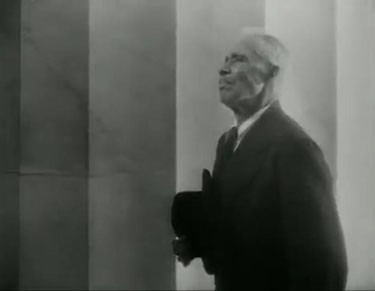
...and sees this gentleman remove his hat, in reverence for...
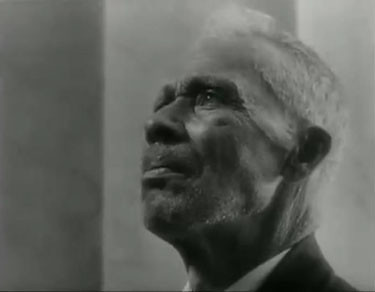
...the freedom that was hard won through a time of great sacrifice.
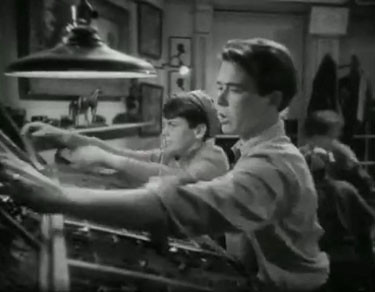
The little four page paper of Jeff's father has become 'Boy Stuff' and a wonderful group of boys put it together.

"Bring on the paper!" this young man shouts as they print a special edition to vindicate Jeff as the Taylor Machine attempts to control the big papers.
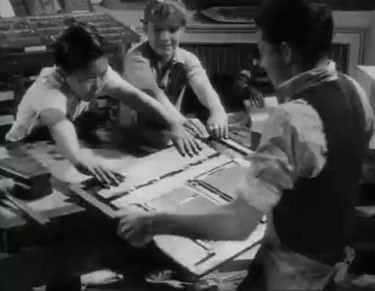
Here they pull page proofs.
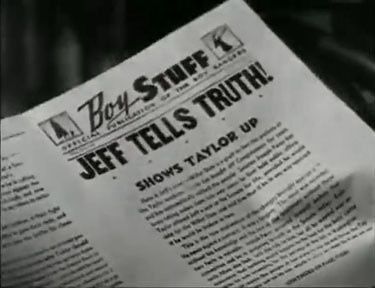
"Jeff Tells Truth!"
It would be a little over two decades before Dr. Martin Luther King would stand at that SAME Memorial to share his "I Have a Dream Speech," but it is clear from the stills above, that Capra is in on the dream. To an America mired in a reality of apartheid, he presents the great truth of IMAGO DEI, through the three characters alongside Smith in the Memorial. The staff of 'Boy Stuff' also presents a group where the dream lives. Though some students of the film have trouble with the "pigeons and the porters" in the scene where Smith arrives in Washington, one must remember that the film was made in the 1930's and also that the porters leave the politicians "holding the pigeons."
In the end, Capra makes a film that is entertaining as it gives us glimpses of that "bright shining city on a hill." Though Capra's Senate Chamber is a movie set, the truth he depicts there is something every American needs to see for themselves.
